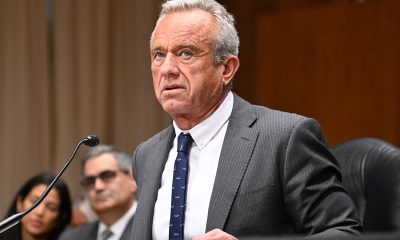a&e features
Unraveling mystery of the Kilbourne Place memorial stones
Three gay men lived in this Mount Pleasant neighborhood before dying of AIDS
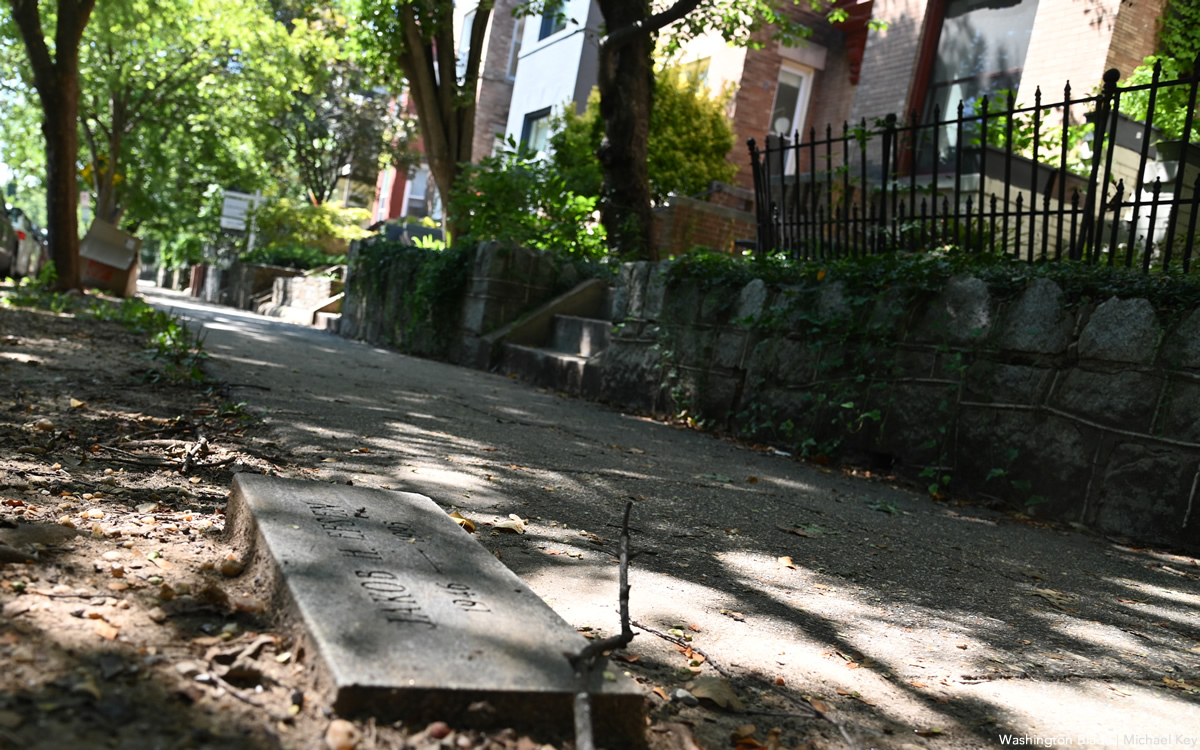
Walking down Kilbourne Place is like stepping into another world. The quiet street lined with row homes is a far cry from the hustle and bustle of Mount Pleasant Street. Mount Pleasant is a village within a city with a thriving El Salvadoran population, long-term residents, and newcomers such as myself. On any given day, Purple Patch is serving up sizzling plates of Sisig and the 43 bus is whizzing its way on its journey to the Kennedy Center. On Kilbourne Place, the sound of sizzling pork and the loud hum of the Metrobus can be heard. Within this little slice of serenity, there are three men that I’ve become acquainted with: Robert Rockerhousen, Jakob Efsen and Charles Winney.
On Aug. 18, 2022, my dear friend Courtney decided that it was a good idea to take a walk around the neighborhood after a long day’s work. As we took a right on Lamont Street to walk up Kilbourne, I decided to slow my pace and lag behind. When I caught up to Courtney, she was standing in front of 1755 Kilbourne Place staring at a patch of grass.
I looked down at what caught her eye. It was a headstone with the name Robert Rockershousen and the years 1959-1998 etched onto it. We both sat there and scratched our heads at this find. Without exchanging words, I stepped a couple of paces to the left and found Jakob Efsen and Charles Winney’s headstones. Courtney and I reconvened back at Robert’s stone and we started to exchange ideas about what these headstones could be.
My first thought was that these were trees planted as a memorial but Courtney reminded me that there were no trees. We said that these could be stones for beloved family pets but the names sounded too human. Getting caught up in trying to find out why headstones would be in this quiet neighborhood, we forgot the years that were etched into them. We both settled on the stones being a memorial for slaves since an enslaved burial ground was found not too far away in Adams Morgan. Now that the mosquitoes were biting at every inch of exposed skin, we settled on this rationale and walked away. Before leaving, I decided to snap a picture.
One glass of wine and a few hours later, I pulled out my phone and took a look at the headstone. The enslaved memorial theory was quickly discarded because I saw the year 1998 clear as day. Doing what most people in my age group do when we’re looking for information, I turned to the Internet. I posted on the r/washingtondc subreddit hoping to ask residents if they knew anything about these stones. The commenters on that post were as confused as I was. Knowing that I needed more information, I walked back down the street the following day and took pictures of Jakob and Charles’s stone. It was on this second trip back and actually paying attention to the stones that a thought started to form.
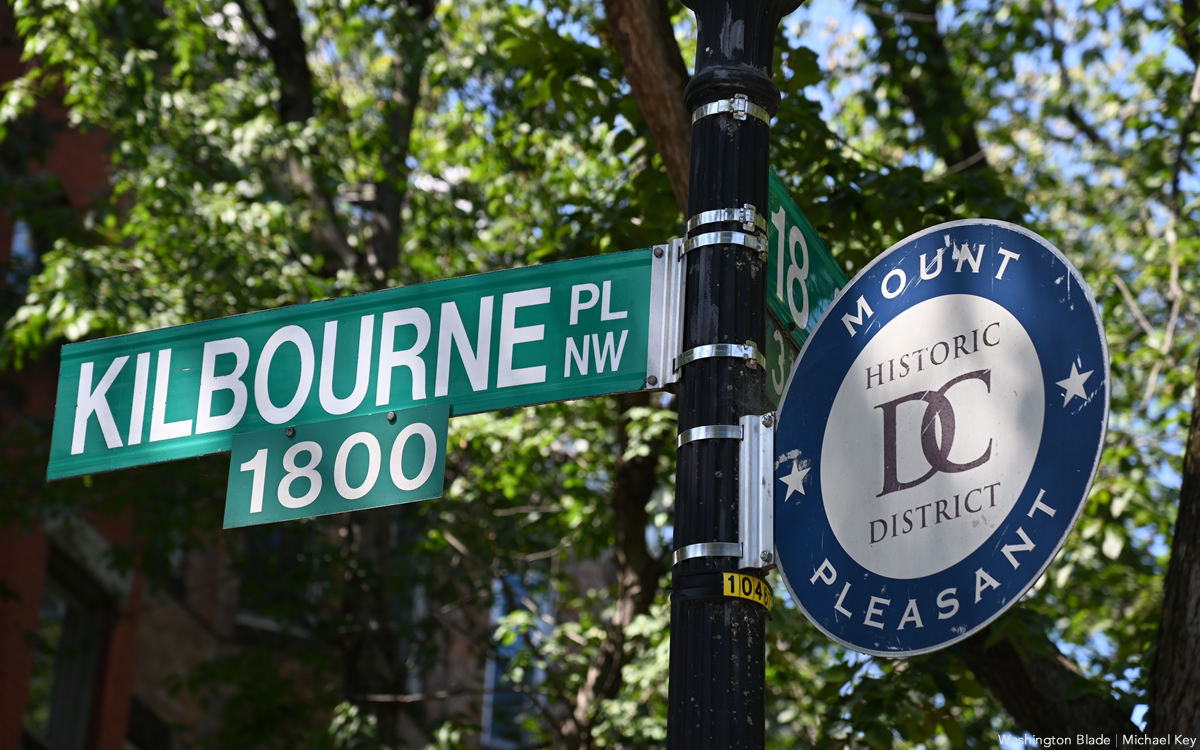
All three of the stones were in honor of men who passed away in the mid-to-late 1990s who were all under 50 years of age. I decided to take another shot at the Internet and back on the r/washingtondc subreddit I made a post soliciting the help of elders in the area’s LGBTQ community. As I was waiting for comments to roll in, I was anxiously checking my phone and refreshing the feed hoping that someone somewhere had answers. No one could say who, what, or when the stones were placed on Kilbourne Place but a few provided some valuable insight on the neighborhood and a few told me to check the Washington Blade’s obituary section with my library card. That night, I spent hours going through each issue in the 1998 archives until I landed on the Nov. 13, 1998 issue. There in black and white was Robert and his cause of death was listed as complications from AIDS.
I went back into the archives and started scrolling through 1996 until I got to July 26, 1996 where I found Charles. In black and white was the cause of death due to complications of AIDS. It took a while for me to find Jakob’s obituary but it was found through the NAMES Project AIDS Memorial Quilt. Even though his cause of death wasn’t explicitly listed as complications from AIDS on his obituary, I knew what that 3×6 panel represented. Here before me were three men who were gay and died from AIDS. At first, my looking into these headstones was something to satiate my curiosity. I was still relatively new to Mount Pleasant and I wanted to know every little thing about the place I now call home. I did not know that this undertaking would become deeply personal for me.
I didn’t fully embrace and accept myself until I turned 25. Growing up, I had conflicting feelings about my sexuality and identity. As young as elementary school I knew I had an attraction to girls and I preferred to present more masculine. Among my friend group, I preferred to be called Tee because Tiana never sounded right to my ears. It wasn’t until adolescence that I also realized I had an attraction to boys. Throughout my adolescent and early adult life, I had visible relationships with men and closeted relationships with women. It was already programmed that there was a “wrongness” within me. I was mocked for my tomboyish appearance. I couldn’t maintain friendships with other girls because they would be immediately labeled as dykes. In college, the dean of my sorority indicated that she would feel “uncomfortable” changing in front of me, implying that there is something inherently predatory about my sexuality.
The closet is where I stayed until June of 2022. Around that time, the walls of the closet started to close in on me and a change needed to happen. I chopped off all of my hair, threw away my feminine clothing, and became Tee again. While this newfound freedom was liberating, there was also a deep sense of regret. When I went to Pride that year I saw a beautiful and vibrant community. A community that I knew nothing about and was afraid of my whole life. Stumbling upon Robert, Charles, and Jake’s headstones as a newly out queer person allowed me an opportunity to learn about a community that I deprived myself of in favor of trying to be “normal.”
I immediately got to work researching everything I could about the men. No longer was finding out the person or entity that placed the headstones an important part of my research. The most important thing was telling the stories of these three men and the lives that they led. Jakob was the first of the three that I started researching. There was already quite a bit of information on him due to his quilt panel. On his panel, there was a pair of cowboy boots and three flags. The cowboy boots represented his love for square dancing. He was a proud member of DC Lambda Squares, which is the area’s LGBTQ square dancing group. DC Lambda Squares members made Jakob’s panel. The three flags represented places that were deeply personal to him. Denmark represents the place he was born. Sweden represents the nationality of his parents, and South Korea represents where Jake served and lived during his time in the PeaceCorps.

Jakob Efsen was born on Feb. 5, 1946 in Denmark. At some point in his childhood, he and his family relocated to Middletown Township, N.J., where he stayed until adulthood. Upon completion of university, he volunteered for the PeaceCorps where he served as a tuberculosis control volunteer in South Korea. In doing research about Jakob, I found a Facebook group of PeaceCorps volunteers who served in Korea. One of his friends, Neil Landreville with whom I had the pleasure speaking, was in K group 13 with Jakob between 1970-1972.
On June 23, 2023, I had the pleasure of speaking with Neil. Neil is now 77 years old and a retired HIV nurse living in New York City. He has a certain youthfulness and brightness to his voice that immediately endears you to him. We stayed on the phone for more than an hour talking about what he knew about Jake and trading stories of our careers in healthcare. Neil met Jake in San Jose where they were roommates for three days before PeaceCorps training in Hawaii. Neil first noticed that Jake was very tall and had an enthusiasm for life. He expressed that the people who knew Jake were immediately taken in by his generosity.
In the weeks they had to learn Korean and how to administer care to people with tuberculosis, Neil fondly remembers how Jake liked to take photos of flowers. Jake went on to become staff for PeaceCorps following the completion of his volunteer term. Being so inspired by the work he did in Korea, Jake came to the DMV area and worked as a tuberculosis case manager in Prince George’s County. Neil expressed that the same reason he worked in the Bronx during the height of the AIDS epidemic is the same reason Jake took on the job in Prince George’s County — he wanted to work directly with the people.
Another fascinating bit about Jake is that he liked to write letters to the editor in response to stories he read in the local newspaper. He was very vocal about his feelings on former Mayor Marion Barry during his drug scandal. He was also vocal about road safety and I have to believe he was passionate about it because he liked to ride his bicycle throughout the neighborhood. Another piece that spoke to me that I remembered when speaking to Neil is one from the Aug. 14, 1987 edition of The Washington Times. The piece was titled “AIDS: The Situation That the U.S. Faces.”
Six years into the AIDS epidemic, the crisis was being ignored by the government. Then-President Ronald Reagan did not mention the word AIDS publicly for years until after his Hollywood friend Rock Hudson came out as gay and revealed that he was living with AIDS. The government was so adamant about not mentioning AIDS that the topic was met with laughter and homophobic remarks in a 1982 press conference in which former Press Secretary Larry Speakes asked reporter Lester Kinsolving if he had AIDS. It wasn’t until the late 1980s when the AIDS death toll was nearing hundreds of thousands did the government expand funding for research and drug development.
In that time of governmental neglect, misinformation, and homophobia, Jake posed a challenge in his piece. He stated, “If Mr. Sobaran thinks the heterosexual population of this nation is safe from the AIDS infection, I suggest he study the incidence of genital herpes in the United States.” In talking with Neil, it was discovered that Jakob already knew he was HIV positive as early as 1990. Neil recounted a visit to D.C. to Jakob’s home where he stayed with his partner. He recalls Jake mentioning that he was taking Bactrim as a prophylactic for PCP (pneumocystis pneumonia). Even though Jake was living with HIV, he continued to work as a tuberculosis case manager all the way up until a couple of weeks before his passing.
Hearing that detail about Jake impressed and also flustered me. Tuberculosis is one of the many opportunistic infections for people living with compromised immune systems. I asked Neil if he was worried about Jake working such a job in his condition and he responded with “that was Jake.” Jakob died on June 5, 1995 with his long-term partner Bradford Jewett by his side. Neil went to the subsequent funeral service where he noticed that it was attended by a majority of his D.C. friends. Still not having any information on Charles and Robert and knowing that they were neighbors, I asked Neil if it would be OK if I sent him photos of Charles and Robert to see if he remembers them at Jake’s service. Unfortunately, he did not recall seeing them there.
Feeling at peace with what I found out about Jake, I started to look into Charles. Charles Winney was born on March 2, 1956 in Saratoga Springs, N.Y., where he lived until moving to Baltimore to attend Johns Hopkins University in 1974 to study to be a pharmacist. It’s unclear how far he made it at Hopkins because he eventually went to the Howard University School of Pharmacy to continue his studies. In looking into Charles’s background, I wanted to find a better photo other than the black and white one used for his obituary. I scoured The Bison (Howard University’s yearbook) looking for any indication of Charles but he wasn’t in there. I continued searching for anything that could lead me to a photo of Charles and a Google search of his name led to a resume.
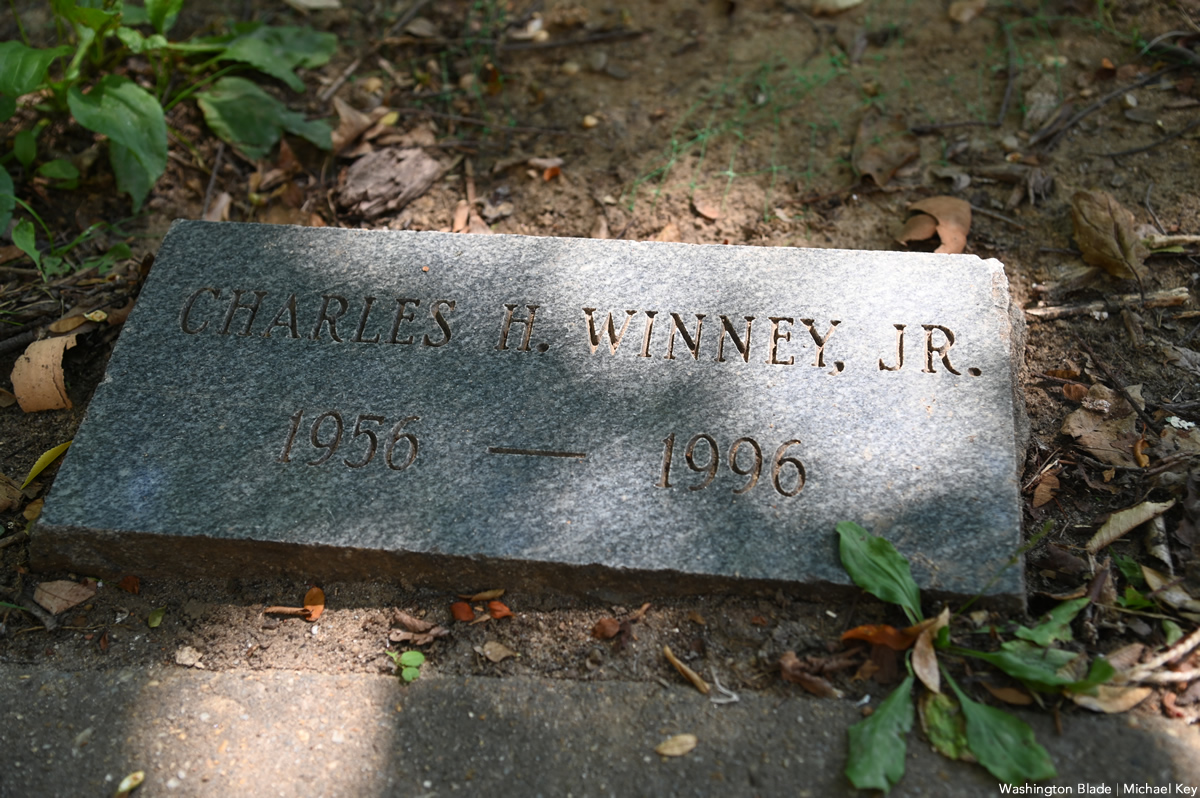
The resume was for a pharmaceutical researcher based out of Kansas. In the section where he listed the people he mentored, Charles was one of his interns in the summer of 1986 and he was listed as a senior. I went back to the 1986 and 1987 issue of The Bison looking for a photo of him and again, there was no photo. It is unclear whether Charles completed his studies at Howard but he worked for the pharmacy at George Washington University Hospital before working at Fidia Pharmaceuticals before retiring on disability in 1993. Charles also worked in the healthcare industry. Unfortunately, not much is known about Charles at this point. I reached out for information to various people but none have yet to respond. Charles passed away on July 11, 1996, with his partner Larry Martin by his side.
While waiting for more information on Charles and Robert, I began to ponder a little bit more about Charles because just like me, he lived at the intersection of Blackness and queerness. That intersection was something that I had to reconcile within myself. In my community, it’s not uncommon to hear someone mention that homosexuality isn’t “African” or that homosexuality is an “agenda” being pushed by the white mainstream media to destroy the Black family structure. The thought that I struggled with through all these years was that by accepting my queerness, I too would be trading in my Blackness. The Black community is a community that had to build itself from the ground up. Through forced migration, we lost most of our native tongue, culture, and history. Some of those have been retained and passed down, which is evident in our music or cultural practices (i.e. jumping the broom at weddings) but it has been blended with the language, culture, and customs by the same people who kidnapped us from Africa.
Christianity was used as a way to instill subservience in slaves. Slave masters and captors frequently quoted Ephesians 6:5 to justify their complicity in bondage to human beings. “Slaves, obey your earthly masters with respect and fear, and with sincerity of heart, just as you would obey Christ,” the verse said. The Black church has become a pillar of the community and incubated the Civil Rights Movement. The Black church is also the same institution that uses Leviticus 20:13 to shun their very own. “If a man lieth with mankind as he lieth with a woman, both of them have committed an abomination,” the verse says.
Even though the Black church is currently experiencing drops in attendance, not too many Black people are far removed from the influence the church has had on our people and unfortunately, homophobia has been one of its influences.
With this history in perspective, in certain parts of the Black community, queerness is viewed as giving into white supremacy where males are seen as giving up their masculinity for a more subservient, feminine position. The women are viewed as wanting to become men in order to escape gender-based oppression and only in finding the “right man,” will the woman return to her “natural” position. Being a Black gay man in the 70s, 80s, and 90s, I wonder how Charles navigated these social issues. For Charles to have been out and in a long-term relationship during those times is a testament to his bravery.
In the process of digging through public records trying to find Charles, an unexpected call came in. Neil forwarded my request for information on Jake to a fellow PeaceCorps friend, Susan Pawlowsky. While she did not know Jake, she does have a love for genealogy. I asked her if she could use her skills to help me find information on Charles and Robert. She agreed and in the information that she sent, she sent the information for Robert’s mother. Acting on faith, I penned a letter and dropped it in the mail to Mrs. Rockerhousen.
On July 1, 2023, I had the pleasure of speaking with Arleen Rockerhousen. I expected to answer questions about my motivations in wanting to know information about her but I was met with a surprisingly sweet and pleasant voice. I told her to tell me what Robert was like and the type of child that he was.
Robert Rockerhousen was born on Aug. 17, 1959 in Michigan. Mrs. Rockerhousen explained that he had a good group of friends growing up but she would often find Robert in his room studying maps. Robert had wanderlust and had wanted to see the world from an early age. This passion for travel was ignited even further when he got a job at a local AAA office in high school where he again was surrounded by maps. After high school, Robert went to the University of Michigan Ann Arbor where he had an internship with Victoria University in Toronto. He graduated with a bachelor’s degree in 1981. Upon completion of his undergraduate studies, Robert took whatever money he had and traveled around Europe until his money ran out.
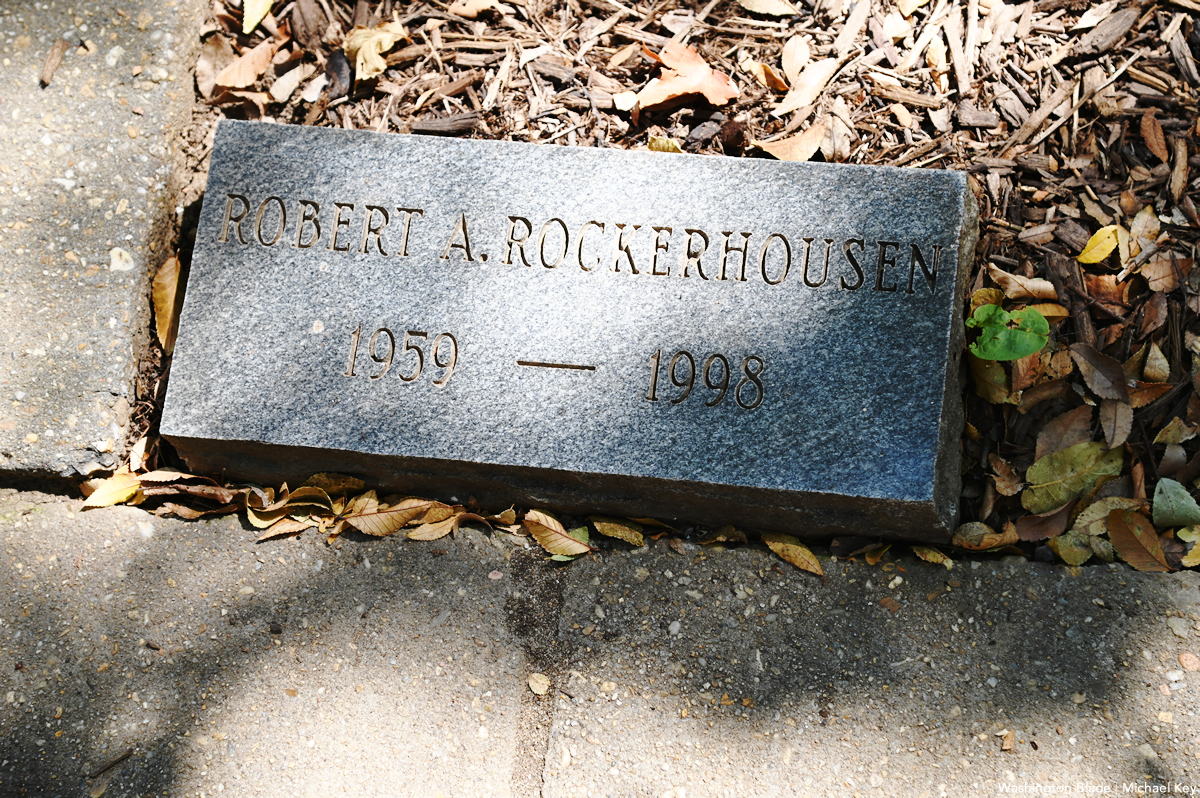
When Robert came back to the states, he worked for American Express Travel Related Services until he eventually landed a job at the World Bank as a tariff specialist in Washington, D.C. Mrs. Rockerhousen was familiar with his group of friends in D.C. I found it quite funny when she mentioned that one of his friends was a cartographer due to his love of maps when he was younger. She also mentioned that she was familiar with Larry and Charles. In her recollection of events, she stated that the property on 1755 Kilbourne Place was not Robert’s primary residence. She stated that it was co-owned by him and his longtime friend John Koran. In a brief exchange with Mr. Koran, it was mentioned that he and Robert did indeed own and live on the property until Robert fell ill and eventually sold it to live with his partner Luis in the Shaw neighborhood.
Mrs. Rockerhousen mentioned that Robert, Charles, and Larry were very close and they enjoyed her cooking whenever she would come over. She mentioned that their favorite dish was her German lasagna. She isn’t quite sure how Robert, Charles, and Larry became friends but she remembers them very fondly. While listening to her reminisce about her son, I did not want to talk about HIV. I grew up in a post antiretroviral world due to being born in late 1996. I never knew a time when HIV was more than just a chronic manageable condition. In researching the AIDS epidemic to gain perspective on the times in which Robert, Charles, and Jake lived, just seeing footage and pictures was more than gutting in and of itself. I could not imagine being a parent and having to witness your child die before their time.
When the topic of HIV came up in regards to her son, Mrs. Rockerhousen spoke with poise and clarity. She mentioned that one of her biggest regrets when it came to Robert was that he couldn’t feel he could come out to her and their family. It wasn’t until Robert fell ill that he came out to them. Nevertheless, Mrs. Rockerhousen was very supportive of Robert and showed up when he needed her. On Nov. 6, 1998, Robert passed away at the age of 39 with his partner Luis Schunk by his side. Mrs. Rockerhousen mentioned that Charles’s partner Larry Martin held a wake for him inside of his house. I tried reaching out to Larry in order to find out more information on Charles, Robert, and if there was any connection to Jake but as of now there has been no response.
I still don’t know who placed those stones on Kilbourne Place and maybe I will never know. At first, I felt like Nancy Drew trying to unravel this mystery but when the lives of these three men unfolded in front of me, the mystery had to take a backseat. In front of me were three men who lived dynamic lives in spite of the AIDS epidemic. Robert, Charles, and Jake lived in their truths in a time when living in your truth could be met with scorn. Living in your truth meant having to witness the government neglect you as a virus was overtaking your community. Living in your truth meant watching friends and loved ones die but still finding community within each other.
When Mrs. Rockerhousen mentioned Larry having Robert’s wake in his own home, that touched me in a way that I could not imagine. It showed the love between friends and between members of a community. That is what these stones represent. Whoever placed these stones on this quiet stretch of street in the middle of Mount Pleasant loved Robert, Charles, and Jake enough to remember them where they felt the most comfortable. They were remembered in a place where they could be free without the prying eyes of the public. They were remembered at home, where the heart truly lives.
a&e features
Tristan Schukraft on keeping queer spaces thriving
New owner of LA’s Abbey expands holdings to Fire Island, Mexico
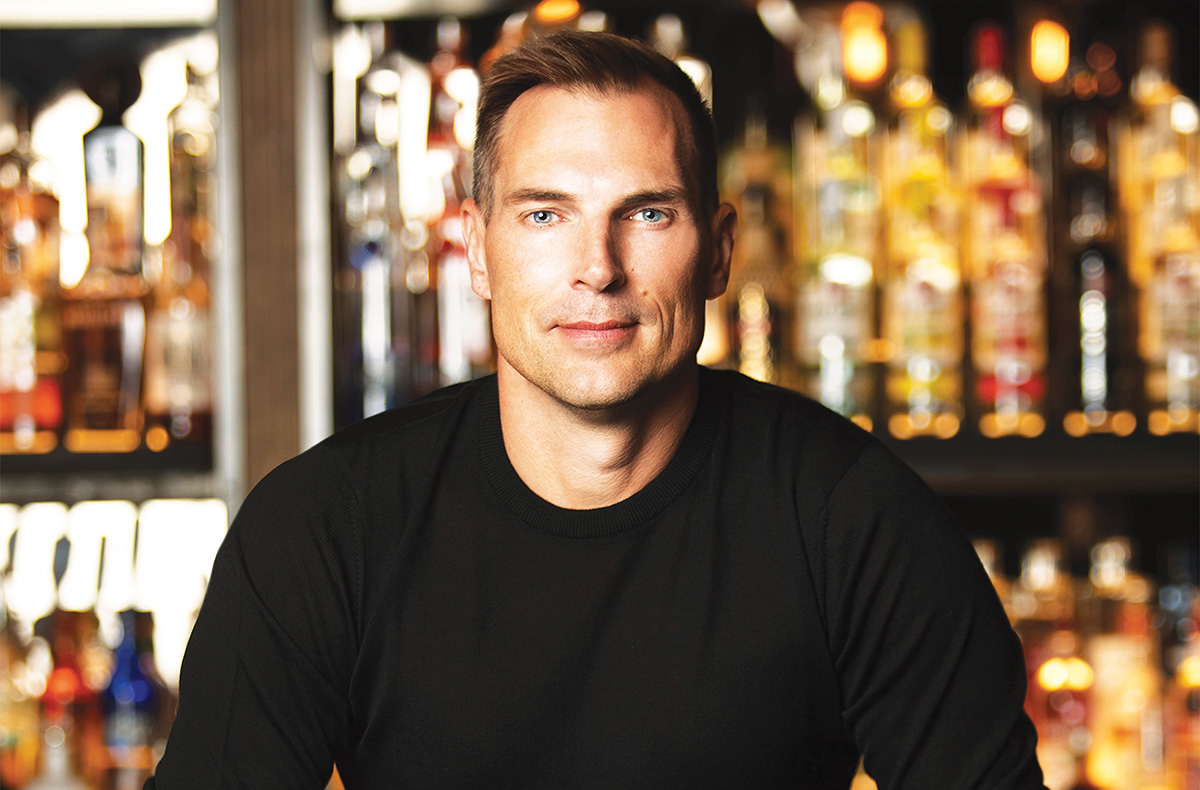
LOS ANGELES — Like the chatter about Willy Wonka and his Chocolate Factory, the West Hollywood community here started to whisper about the man who was going to be taking over the world-famous Abbey, a landmark in Los Angeles’s queer nightlife scene. Rumors were put to rest when it was announced that entrepreneur Tristan Schukraft would be taking over the legacy created by Abbey founder David Cooley. All eyes are on him.
For those of us who were there for the re-opening of The Abbey, when the torch was officially passed, all qualms about the new regime went away as it was clear the club was in good hands and that the spirit behind the Abbey would forge on. Cher, Ricky Martin, Bianca del Rio, Jean Smart, and many other celebrities rubbed shoulders with veteran patrons, and the evening was magical and a throwback to the nightclub atmosphere pre-COVID.
The much-talked-about purchase of the Abbey was just the beginning for Schukraft. It was also announced that this business impresario was set to purchase the commercial district of Fire Island, as well as projects launching in Mexico and Puerto Rico. What was he up to? Tristan sat down with the Blade to chat about it all.
“We’re at a time right now when the last generation of LGBT entrepreneurs and founders are all in their 60s and they’re retiring. And if somebody doesn’t come in and buy these places, we’re going to lose our queer spaces.”
Tristan wasn’t looking for more projects, but he recounts what happened in Puerto Rico. The Atlantic Beach Hotel was the gay destination spot and the place to party on Sundays, facing the gay beach. A new owner came in and made it a straight hotel, effectively taking away a place of fellowship and history for the queer community. Thankfully, the property is gay again, now branded as the Tryst and part of Schukraft’s portfolio with locations in Puerto Vallarta and Fire Island.
“If that happens with the Abbey and West Hollywood, it’s like Bloomingdale’s in a mall. It’s kind of like a domino effect. So that’s really what it is all about for me at this point. It has become a passion project, and I think now more than ever, it’s really important.”
Tristan is fortifying spaces for the queer community at a time when the current administration is trying to silence the LGBTQ+ community. The timing is not lost on him.
“I thought my mission was important before, and in the last couple of months, it’s become even more important. I don’t know why there’s this effort to erase us from public life, but we’ve always been here. We’re going to continue to be here, and it brings even more energy and motivation for me to make sure the spaces that I have now and even additional venues are protected going in the future.”
The gay community is not always welcoming to fresh faces and new ideas. Schukraft’s takeover of the Abbey and Fire Island has not come without criticism. Who is this man, and how dare he create a monopoly? As Schukraft knows, there will always be mean girls ready to talk. In his eyes, if someone can come in and preserve and advance spaces for the queer community, why would we oppose that?
“I think the community should be really appreciative. We, as a community, now, more than ever, should stand together in solidarity and not pick each other apart.”
As far as the Abbey is concerned, Schukraft is excited about the changes to come. Being a perfectionist, he wants everything to be aligned, clean, and streamlined. There will be changes made to the DJ and dance booth, making way for a long list of celebrity pop-ups and performances. But his promise to the community is that it will continue to be the place to be, a place for the community to come together, for at least another 33 years.
“We’re going to build on the Abbey’s rich heritage as not only a place to go at night and party but a place to go in the afternoon and have lunch. That’s what David Cooley did that no others did before, is he brought the gay bar outside, and I love that.”
Even with talk of a possible decline in West Hollywood’s nightlife, Schukraft maintains that though the industry may have its challenges, especially since COVID, the Abbey and nightlife will continue to thrive and grow.
“I’m really encouraged by all the new ownership in [nightlife] because we need another generation to continue on. I’d be more concerned if everybody was still in their sixties and not letting go.”
In his opinion, apps like Grindr have not killed nightlife.
“Sometimes you like to order out, and sometimes you like to go out, and sometimes you like to order in, right? There’s nothing that really replaces that real human interaction, and more importantly, as we know, a lot of times our family is our friends, they’re our adopted family.
Sometimes you meet them online, but you really meet them going out to bars and meeting like-minded people. At the Abbey, every now and then, there’s that person who’s kind of building up that courage to go inside and has no wingman, doesn’t have any gay friends. So it’s really important that these spaces are fun, to eat, drink, and party. But they’re really important for the next generation to find their true identity and their new family.”
There has also been criticism that West Hollywood has become elitist and not accessible to everyone in the community. Schukraft believes otherwise. West Hollywood is a varied part of queer nightlife as a whole.
“West Hollywood used to be the only gay neighborhood, and now you’ve got Silver Lake and you’ve got parts of Downtown, which is really good because L.A., is a huge place. It’s nice to have different neighborhoods, and each offers its own flavor and personality.”
Staunch in his belief in his many projects, he is not afraid to talk about hot topics in the community, especially as they pertain to the Abbey. As anyone who goes to the Abbey on a busy night can attest to, the crowd is very diverse and inclusive. Some in the community have started to complain that gay bars are no longer for the gay community, but are succumbing to our straight visitors.
Schukraft explains: “We’re a victim of our own success. I think it’s great that we don’t need to hide in the dark shadows or in a hole-in-the-wall gay bar. I’m happy about the acceptance. I started Tryst Hotels, which is the first gay hotel. We’re not hetero-friendly, we’re not gay-friendly. We’re a gay hotel and everyone is welcome. I think as long as we don’t change our behavior or the environment in general at the Abbey, and if you want to party with us, the more than merrier.”
Schukraft’s message to the community?
“These are kind of dangerous times, right? The rights that we fought for are being taken away and are being challenged. We’re trying to be erased from public life. There could be mean girls, but we, as a community, need to stick together and unite, and make sure those protections and our identity aren’t erased. And even though you’re having a drink at a gay bar, and it seems insignificant, you’re supporting gay businesses and places for the next generation.”
a&e features
Creator Max Mutchnick on inspirations for ‘Mid-Century Modern’
Real-life friendships and loss inform plot of new Hulu show
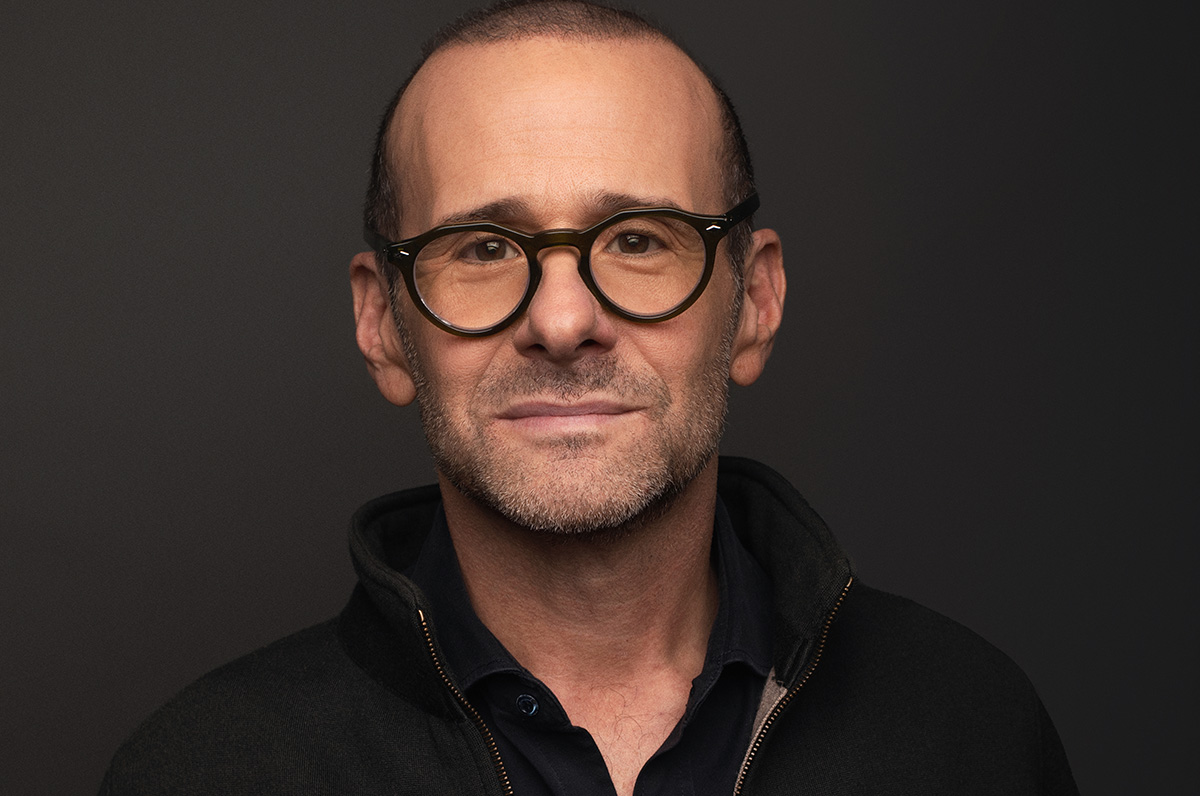
It’s been a long time – maybe 25 years when “Will & Grace” debuted – since there’s been so much excitement about a new, queer sitcom premiering. “Mid-Century Modern,” which debuted on Hulu last week, is the creation of Max Mutchnick and David Kohan, the gay men who were also behind “Will & Grace.”
Set in Palm Springs, Calif., following the death of the one of their closest friends, three gay men gather to mourn. Swept up in the emotions of the moment, Bunny (Nathan Lane) suggests that Atlanta-based flight attendant Jerry (Matt Bomer) and New York-based fashion editor Arthur (Nathan Lee Graham) move into the mid-century modern home he shares with his mother Sybil (the late Linda Lavin). Over the course of the first season’s 10 episodes, hilarity ensues. That is, except for the episode in which they address Sybil’s passing. The three male leads are all fabulous, and the ensemble cast, including Pamela Adlon as Bunny’s sister Mindy, and the stellar line-up of guest stars, such as Jesse Tyler Ferguson, Vanessa Bayer, Richard Kind, and Cheri Oteri, keep humor buzzing. Shortly before the premiere of “Mid-Century Modern,” Mutchnick made time for an interview with the Blade.
BLADE: I’d like to begin by saying it’s always a delight to speak to a fellow Emerson College alum. In ways would you say that Emerson impacted your professional and creative life?
MAX MUTCHNICK: I think Emerson was the first place that reflected back to me that my voice, my thoughts were good, and they were worth listening to. I developed a confidence at Emerson that did not exist in my body and soul. It was a collection of a lot of things that took place in Boston, but I mean we can just put it all under the Emerson umbrella.
BLADE: Before “Will & Grace,” you co-created the NBC sitcom “Boston Common,” which starred fellow Emerson alum Anthony Clark. Is it important for you to maintain those kinds of alumni relationships?
MUTCHNICK: Because Emersonians are such scrappy little monkeys and they end up being everywhere in the world, you can’t help but work with someone from Emerson at some point in your career. I’m certainly more inclined to engage with someone from Emerson once I learn that they went to my alma mater. For me, it has much more to do with history and loyalty. I don’t think of myself as one of those guys that says, “Loyalty means a lot to me. I’m someone that really leans into history.” It’s just what my life and career turned out to be. The longer I worked with people and the more often I worked with them, the safer that I felt, which means that I was more creative and that’s the name of the game. I’ve got to be as comfortable as possible so I can be as creative as possible. If that means that a person from Emerson is in the room, so be it. (Costume designer) Lori Eskowitz would be the Emerson version. And then (writer and actor) Dan Bucatinsky would be another version. When I’m around them for a long time, that’s when the best stuff comes.
BLADE: Relationships are important. On that subject, your new Hulu sitcom “Mid-Century Modern” is about the longstanding friendship among three friends, Bunny (Nathan Lane), Jerry (Matt Bomer), and Arthur (Nathan Lee Graham). Do you have a friendship like the one shared by these three men?
MUTCHNICK: I’m absolutely engaged in a real version of what we’re projecting on the show. I have that in my life. I cannot say that I’m Jerry in any way, but the one thing that we do have in common is that in my group, I’m the young one. But I think that that’s very common in these families that we create. There’s usually a young one. Our culture is built on learning from our elders. I didn’t have a father growing up, so maybe that made me that much more inclined to seek out older, wiser, funnier, meaner friends. I mean the reason why you’re looking at a mouthful of straight, white teeth is because one of those old bitches sat across from me about 25 years ago at a diner and said, “Girl, your teeth are a disaster, and you need to get that fixed immediately.” What did I know? I was just a kid from Chicago with two nickels in my pocket. But I found three nickels and I went and had new teeth put in my head. But that came from one of my dearest in the group.
BLADE: Do you think that calling “Mid-Century Modern” a gay “Golden Girls” is a fair description?
MUTCHNICK: No. I think the gay “Golden Girls” was really just used as a tool to pitch the show quickly. We have an expression in town, which is “give me the elevator pitch,” because nobody has an attention span. The fastest way you can tell someone what David (Kohan) and I wanted to write, was to say, “It’s gay Golden Girls.” When you say that to somebody, then they say, “OK, sit down now, tell me more.” We did that and then we started to dive into the show and realized pretty quickly that it’s not the gay “Golden Girls.” No disrespect to the “Golden Girls.” It’s a masterpiece.
BLADE: “Mid-Century Modern” is set in Palm Springs. I’m based in Fort Lauderdale, a few blocks south of Wilton Manors, and I was wondering if that gay enclave was ever in consideration for the setting, or was it always going to be in Palm Springs?
MUTCHNICK: You just asked a really incredible question! Because, during COVID, Matt Bomer and I used to walk, because we live close by. We had a little walking group of a few gay gentlemen. On one of those walks, Matt proposed a comedy set in Wilton Manors. He said it would be great to title the show “Wilton Manors.” I will tell you that in the building blocks of what got us to “Mid-Century Modern,” Wilton Manors, and that suggestion from Matt Bomer on our COVID walks, was part of it.
BLADE: Is Sybil, played by the late Linda Lavin, modeled after a mother you know?
MUTCHNICK: Rhea Kohan (mother of David and Jenji). When we met with Linda for the first time over Zoom, when she was abroad, David and I explained to her that this was all based on Rhea Kohan. In fact, some of the lines that she (Sybil) speaks in the pilot are the words that Jenji Kohan spoke about her mother in her eulogy at the funeral because it really summed up what the character was all about. Yes, it’s very much based on someone.
BLADE: The Donny Osmond jokes in the second episode of “Mid-Century Modern” reminded me of the Barry Manilow “fanilows” on “Will & Grace.” Do you know if Donny is aware that he’s featured in the show?
MUTCHNICK: I don’t. To tell you the truth, the “fanilow” episode was written when I was not on the show. I was on a forced hiatus, thanks to Jeff Zucker. That was a show that I was not part of. We don’t really work that way. The Donny Osmond thing came more from Matt’s character being a Mormon, and also one of the writers. It’s very important to mention that the writing room at “Mid-Century Modern,” is (made up of) wonderful and diverse and colorful incredible humans – one of them is an old, white, Irish guy named Don Roos who’s brilliant…
BLADE: …he’s Dan Bucatinsky’s husband.
MUTCHNICK: Right! Dan is also part of the writing room. But I believe it was Don who had a thing for Donny, and that’s where it comes from. I don’t know if Donny has any awareness. The only thing I care about when we turn in an episode like that is I just want to hear from legal that we’re approved.
BLADE: “Mid-Century Modern” also includes opportunities for the singers in the cast. Linda Lavin sang the Jerome Kern/Ira Gershwin tune “Long Ago (And Far Away)” and Nathan Lane and the guys sang “He Had It Coming” from “Chicago.” Was it important to give them the chance to exercise those muscles?
MUTCHNICK: I don’t think it was. I think it really is just the managers’ choice. David Kohan and I like that kind of stuff, so we write that kind of stuff. But by no means was there an edict to write that. We know what our cast is capable of, and we will absolutely exploit that if we’re lucky enough to have a second season. I have a funky relationship with the song “Long Ago (And Far Away).” It doesn’t float my boat, but everybody else loved it. We run a meritocracy, and the best idea will out. That’s how that song ended up being in the show. I far prefer the recording of Linda singing “I’ll Be Seeing You” over her montage in episode eight, “Here’s To You, Mrs. Schneiderman.” We were just lucky that Linda had recorded that. That recording was something that she had done and sent to somebody during COVID because she was held up in her apartment. That’s what motivated her to make that video and send it. That’s how we were able to use that audio.
BLADE: Being on a streaming service like Hulu allows for characters to say things they might not get away with on network TV, including a foreskin joke, as well as Sybil’s propensity for cursing.
MUTCHNICK: And the third line in the show is about him looking like a “reluctant bottom.” I don’t think that’s something you’re going to see on ABC anytime soon. David and I liked the opportunity to open up the language of this show because it might possibly open the door to bringing people…I’m going to mix metaphors…into the tent that have never been there before. A generation that writes off a sitcom because that language and that type of comedy isn’t the way that they sound. One of the gifts of doing this show on Hulu is that we get to write dialogue that sounds a little bit more like you and I sound. As always, we don’t want to do anything just to do it.
BLADE: It didn’t feel that way.
MUTCHNICK: It’s there when it’s right. [Laughs] I want to have a shirt made with Linda’s line, as her mother always used to say, “Time is a cunt.”
BLADE: “Mid-Century Modern” also utilizes a lot of Jewish humor. How important is it for you to include that at this time when there is a measurable rise in anti-Semitism?
MUTCHNICK: I think it’s important, but I don’t think it’s the reason why we did it. We tried very hard to not write from a place of teaching or preaching. We really are just writing about the stuff that makes us laugh. One of the things that makes something better and something that you can invest in is if it’s more specific. We’re creating a character whose name is Bunny Schneiderman and his mother’s name is Sybil and they made their money in a family-run business, it gets Jewy, and we’re not going to shy away from it. But we’re definitely not going to address what’s going on in the world. That doesn’t mean I don’t find it very upsetting, but I’m writing always from the point of view of entertaining the largest number of people that I can every week.
BLADE: “Mid-Century Modern” has a fantastic roster of guest stars including Jesse Tyler Ferguson, Vanessa Bayer, Billie Lourd, Cheri Oteri, Richard Kind, Rhea Perlman, and Judd Hirsch. Are there plans to continue that in future seasons?
MUTCHNICK: Yes. As I keep saying, if we’re so lucky that we get to continue, I don’t want to do “The Love Boat.” Those are fine comic actors, so I don’t think it feels like that. But if we get to keep going, what I want to do is broaden the world because that gives us more to write about. I want to start to introduce characters that are auxiliary to the individuals. I want to start to meet Arthur’s family, so we can return to people. I want to introduce other neighbors, and different types of gay men because we come in so many different flavors. I think that we should do that only because I’m sure it’s what your life is and it’s what my life is. I’ve got a lot of different types. So, yes, we will be doing more.
BLADE: Finally, Linda Lavin passed away in December 2024, and in a later episode, the subject of her character Sybil’s passing is handled sensitively, including the humorous parts.
MUTCHNICK: We knew we had a tall order. We suffered an incredible loss in the middle of making this comedy. One of the reasons why I think this show works is because we are surrounded by a lot of really talented people. Jim Burrows and Ryan Murphy, to name two. Ryan played a very big role in telling us that it was important that we address this, that we address it immediately. That we show the world and the show goes on. That wasn’t my instinct because I was so inside the grief of losing a friend, because she really was. It wasn’t like one of those showbizzy-type relationships. And this is who she was, by the way, to everybody at the show. It was the way that we decided to go. Let’s write this now. Let’s not put this at the end of the season. Let’s not satellite her in. Let’s not “Darren Stevens” the character, which is something we would never do. The other thing that Jim Burrows made very clear to us was the import of the comedy. You have to write something that starts exactly in the place that these shows start. A set comedy piece that takes place in the kitchen. Because for David and me, as writers, we said we just want to tell the truth. That’s what we want to do with this episode and that’s the way that this will probably go best for us. The way that we’ve dealt with grief in our lives is with humor. That is the way that we framed writing this episode. We wanted it to be a chapter from our lives, and how we experience this loss and how we recover and move on.
a&e features
Margaret Cho returns to music with ‘Lucky Gift’
Collection of pop tunes includes tribute to non-binary people
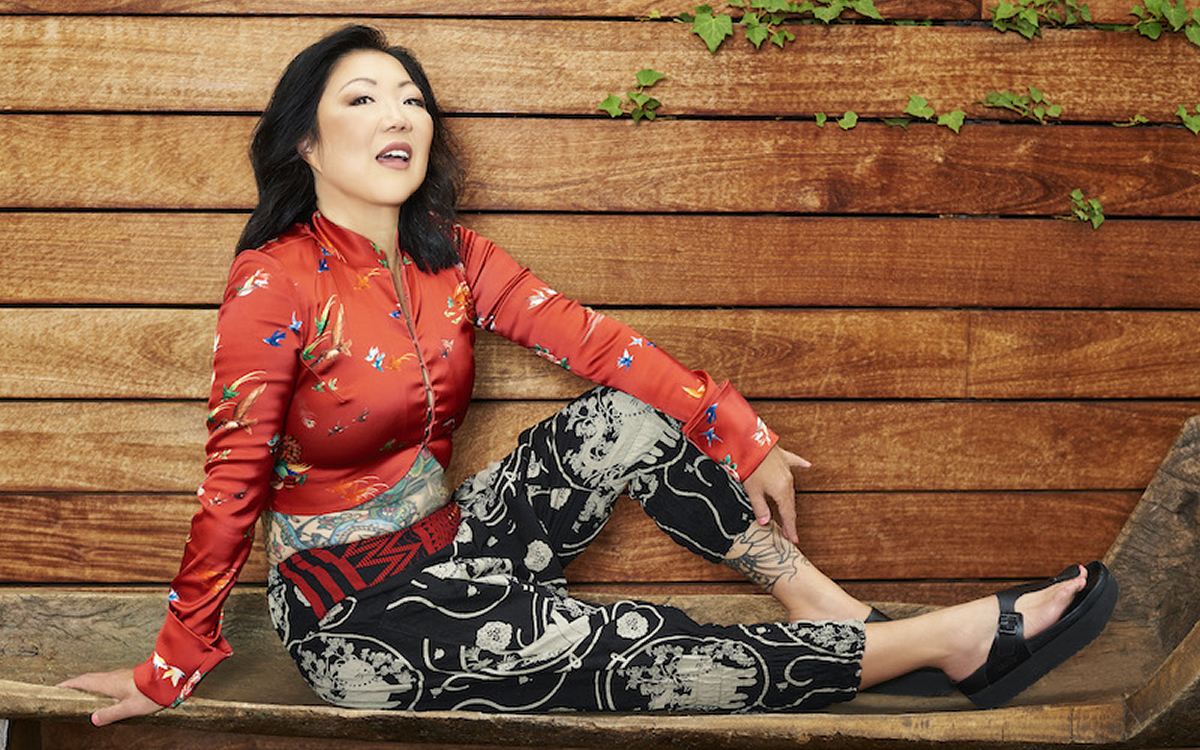
LOS ANGELES — It has been eight years since Margaret Cho released her Grammy-nominated “American Myth” album. She’s back to the music scene with her new album, “Lucky Gift,” an 11-track collection of anthems and pop tunes, a tribute to Robin Williams, and a shout-out to non-binary and gender non-conforming people.
The album captures the whirlwind that is Margaret and all of the different facets of her talents that have made her a powerhouse in entertainment and a leader in activism. In “Lucky Gift,” she’s getting her point across while having fun and getting glam.
We caught up with the activist and artist to chat about her music, our political climate, and the power of pop divas.
Known for her comedy, acting, and activism, she felt it was long overdue to get her music back out there too.
“I make music often. It’s a part of my daily life, it’s a big part of my social life, and it’s just something that I just love to do for my own relaxation and fun. I had enough for an album and I wanted to finally put them out. I was just really proud of how it all sounded together,” shares Cho.
“It’s a power pop record. For me, the songs are really meaningful. They’re all in their own way love songs. I’m a big fan of my own music (laughs), I really like the way that I sound and it’s really special to do. People know me as a comedian, and I have also made music for a long time, but it’s sort of a side project, and so it was time to put more out again.”
Her album also includes a touching tribute to Robin Williams. The entertainment community is finally more comfortable talking about mental health more openly. When relating mental health to her own life, Margaret, in true Margaret form, quickly turned the conversation to reflect today’s political climate.
“I have to maintain a level of peace and quiet and sometimes maybe get away from the news, although that’s tough because I am obsessed. I want to know what is happening. I’m really worried for our community, especially the trans community. I’m worried that this administration is trying to separate T and the Q from the LGBTQIA, and it’s really frightening.”
As an elder, Cho says she has to also remember that we’ve been through this before and it’s actually been much worse. As a community, we’ve been through a similar situation, and we were facing down a pandemic, which was killing us by the millions. So at least now we don’t have to fight AIDS as well as this onslaught of homophobia.
“We have fought for our rights, and we still have them, but we may not have them for long. So our mental health is very important to preserve now because we have to fight. The one thing to remember is they can’t do everything at once. They can’t take away trans rights, queer rights, gay rights, gay marriage, anti-depressants —ha — at the same time. So what we can do is just try to remain as calm as possible and fight as strongly as we can. But yeah, mental health is really vitally important right now.”
Margaret’s long history of queer activism stands for itself. She does not shy away from current issues, she uses her platforms to incite, educate, and question. For Margaret, there is no time off from being an activist. She was born into it, so to speak, being raised in San Francisco in the 1970s, her parents — the owners of a gay bookstore — and their employees followers of Harvey Milk.
“My activism is that I don’t have a choice. I’m going to be an activist no matter what. We’re doing this together, we’re going through this together. I will always be political. It’s just disheartening to see the ignorance of people and the lies that are being told that are believed.”
Margaret’s “Lucky Gift” comes at a perfect time when the queer community can come together over music. Cho looks at her album as a tool to empower an underdog community through the power of music.
“It’s the triumph of pop above all. We need to look to our pop divas above all. So now I’m more than ever, leaning on Madonna. [Thank God for Lady Gaga’s] “Abracadabra” because I think that things like that boost our community so much. When you can just get together and have a “brat summer,” that boosts our community so much in this togetherness, this explosion of excitement. I think Chappell Roan really ignited the pop capacity for healing. I love ‘Lucky Gift’ because it is my stepping into a pop diva moment. Pop divas should not be discounted for how important they are to our society and how much they lift us up.”
In addition to releasing her new album, Cho will continue to hit the road this year with her “Live and LIVID! Tour,” celebrating more than four decades of live stand-up shows. On this tour, she promises to rage about homophobia, sexism, racism, and the fight to stay alive. The five-time Grammy and Emmy-nominated performer is not holding back. According to her, the nation is not divided, just a little lost.
“We’re not divided. Everybody hates this. We all hate this. The fact is, the majority of the country does not want this. Unfortunately, a lot of people just didn’t vote because they just didn’t want to participate. That’s why we’re in the situation that we’re in. So to be on the road is a pleasure. And I rarely come against opposition. Every once in a while there’s something, but it’s something that we all handle. I think we all need a voice, a strong voice of reason to combat all of the hysteria.”
And her message to her fans?
“We’ll get through this. We’ll get through this with pop divas. ‘Abracadabra,’ learn the choreography, you do it sitting down. At least we have pop music, I have my hat in the ring here. But at least we have each other and we’re going to be OK. It’s going to be a ride, it’s going to be intense, but we can do this. We’ve been through this before and we are going to be fine.”
“Lucky Gift”is now available on all major streaming platforms.
-

 District of Columbia2 days ago
District of Columbia2 days agoReenactment of 1965 gay rights protest at White House set for April 17
-
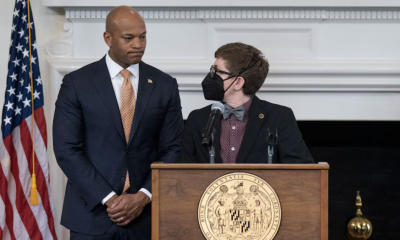
 Maryland3 days ago
Maryland3 days agoFreeState Justice: Transgender activist ‘hijacked’ Moore’s Transgender Day of Visibility event
-

 Hungary3 days ago
Hungary3 days agoHungarian MPs amend constitution to ban public LGBTQ events
-

 Real Estate3 days ago
Real Estate3 days agoNavigating DMV real estate market during political unrest



